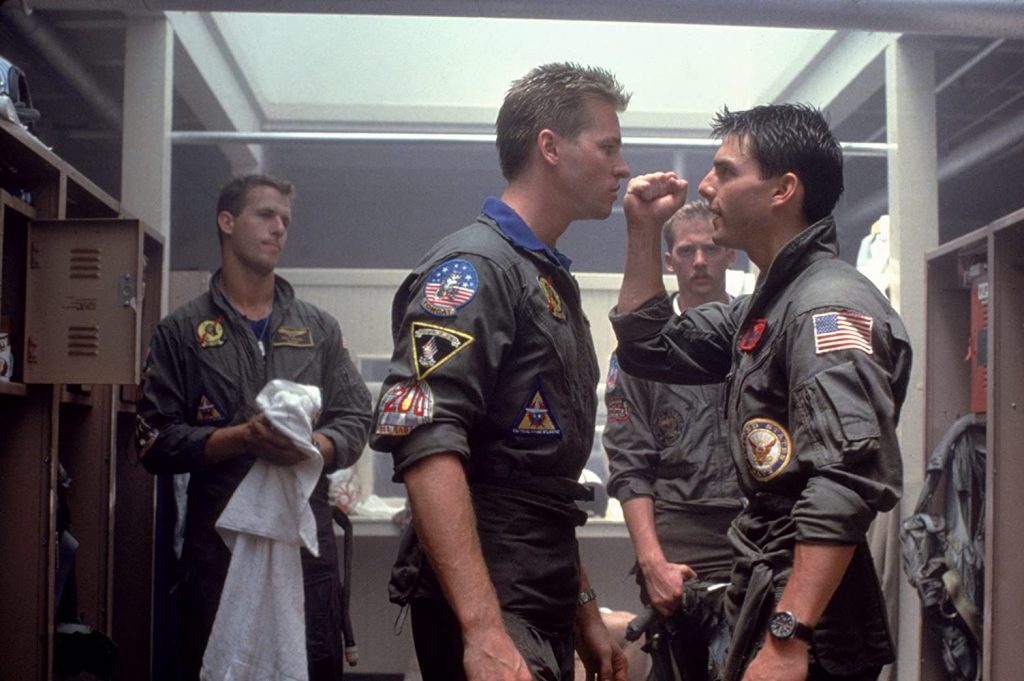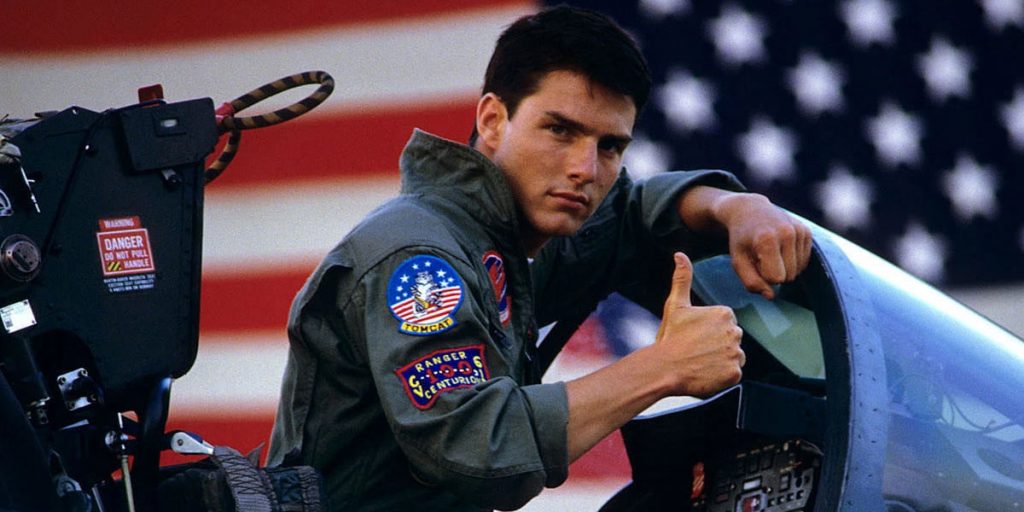Top Gun (1986)’s ageless appeal pervades pop culture to this day, but some still view it as little more than noxious nationalism.
Ardently admired for its state-of-the-art aerial stunt work, steadily spoofed for its self-serious silliness, and constantly criticized for its ceaseless jingoism, Top Gun has left behind quite a labyrinthine and layered legacy since its original release in 1986. Despite initial mixed critical reception (including pans that labeled it as “pro-military propaganda”), Tony Scott’s cinematic classic captivated the culture in a way that few films do, eventually earning $176.8 million at the domestic box office and becoming the highest grossing picture of that year. In addition, the action drama’s significance was felt elsewhere in society, as the sales for bomber jackets and Ray-Ban Aviator sunglasses skyrocketed, the number of male US Naval Aviator applicants increased by 500%, and the film’s signature soundtrack – featuring sensational singles such as “Danger Zone” and “Take My Breath Away” – reached 9x Platinum certification (with the latter hit receiving the Academy Award for Best Original Song).
To this day, Top Gun remains reverently remembered as a generational gem, but it also still suffers from all sorts of slander surrounding its affiliation with the U.S. Army. Therefore, in this fourth edition of “Flashback Films,” we re-explore this 80s epic from the eyes of our modern era, breaking down the film’s beguiling bombast and investigating the military’s much-debated involvement in the movie’s production.
Top Gun highlights the heroics of a nervy naval aviator named “Maverick” Mitchell (a spectacular star-making turn for Tom Cruise) and his Radar Intercept Officer/best bud “Goose” (Anthony Edwards, of ER), who winsomely work their way through a taxing training program at the U.S. Navy’s Fighter Weapons School, most commonly known as – you guessed it – TOPGUN. While there, Maverick makes enemies with a fellow student by the name of “Iceman” (Val Kilmer, of Heat and Batman Forever), falls for his fierce female instructor (Kelly McGillis, of Witness and The Accused), and takes part in a plethora of exhilarating exercises that test the limits of his talents, all while additionally grappling with the grief he’s carried with him since his father’s untimely death.

Though there are a surplus of (somewhat surface-level) storylines occurring simultaneously in Top Gun, the film never lets you forget that its primary focus is always on its astonishing action, first and foremost. And, indeed, the adventure’s aerial antics are assuredly astounding. Director Tony Scott (Beverly Hills Cop II, Man on Fire) captures these capers with a confident and courageous command, while cinematographer Jeffrey L. Kimball (Mission: Impossible II, The Expendables) shoots the skies with well-suited splendor and sumptuousness, spotlighting the staggering spectacle of these sequences. With some sincerely stunning sound design complementing these valiant visuals, it’s simple to see why fans flocked to take flight with the likes of “Maverick” and “Goose” throughout the summer of ’86. In terms of big-screen blockbusters, Top Gun couldn’t be beat.
Now, in regards to Top Gun’s actual narrative, perhaps no one offered a better analysis than famed film critic Roger Ebert, who once warned audiences to “look out for the scenes where the people talk to one another”; given that the film’s script is admittedly as thin as the paper it was printed on, he can’t necessarily be rebuked for these remarks. Countless character interactions simply serve as connective tissue for the aforementioned animative action sequences, and there is a definite dearth of depth of any kind (for either the protagonists or the plot itself).
However, even though much of the dialogue in Top Gun is overwhelmingly overblown and needlessly nonsensical, the picture’s performers somehow portray this preposterousness perfectly, acting out the aggressive absurdity on display with reckless abandon and captivating crowds regardless. Much has been said of the movie’s melodramatic machismo (and this may certainly be some of the most chauvinistic cinema ever captured on camera), but even today, there is some sort of odd allure to these colorful, cocky characters, and the fact that the film seems to be “in” on its outrageousness adds to appeal.
No one toes this line of smugness and sincerity better than Cruise, who struts through every scene with the swagger of a “Star-with-a-capital-S,” flashing his glowing grin as often as possible and boasting a bewitching bravado that one cannot look away from, no matter how hard they try. Without such a larger-than-life lead, it’s very likely that Top Gun would have crumbled beneath all of its inanity, but Cruise keeps the chronicle under control with his cocksure charisma. Surrounding him is a supporting cast that magnificently matches his magnetism, including Kilmer’s inhospitable “Iceman” (who proves to be a ferocious foil for Cruise), Edwards’ gloriously goofy “Goose,” and, most notably, McGillis’s calculated but compassionate Charlie. In only her third major movie role, McGillis more than holds her own against the commanding Cruise, and the chemistry between the two crackles from their first conversation, supplying the film with a fascinating flirtation for fervent female fans to latch onto. In many ways, after taking all of the above into account (from the audacious action to the riveting romance), it seems as if Top Gun was practically scientifically engineered for success, with story elements that enticed each and every potential viewer around the world.

And yet, for all of Top Gun’s engaging entertainment value, there are some who have continually found its charms less than compelling. For starters, the U.S. Navy’s active participation in the film’s production has been a constant point of contention for the past 34 years. As well as providing background knowledge on army affairs for the sake of simulating some semblance of realism, the Navy even exercised approval over the film’s script, reshaping and restructuring scenes when they saw fit (a privileged position they came to possess after offering warplanes and aircraft carriers to Paramount at a “discount”). In a post-Vietnam world, where many Americans still felt apprehensive towards the actions of the U.S. Army, the control the Navy held over their characterization likely prevented any potential “critiques” or “criticisms” of any kind and instead offered audiences a “censored” view of their conduct.
Furthermore, when Top Gun was released, the Navy set up recruitment tables at theaters across the nation in order to attract ambitious applicants who left the film eager to emulate the efforts of “Maverick” and “Goose” and bravely go off to battle on behalf of their country; this helps to explain the aforementioned steep spike in the number of men interested in pursuing US Naval Aviator placements. Aside from expanding the Army’s engagement with prospective recruits, Top Gun has also been associated with aiding the military in its attempts to amplify public confidence in the armed forces, as polls posted after the film took America by storm indicated sky-high levels of support.
Now, all of this information isn’t meant to suggest that the U.S. Navy’s involvement in Top Gun is intentionally injurious to audiences by any means, but it is nevertheless essential that the film’s admirers are aware of this added context to the patriotic pomp and circumstance they see onscreen. One can enjoy the extravagance and excitement of the affecting action and gawk at Tom Cruise’s good looks as much as they wish without feeling “guilty,” as long as they additionally acknowledge that the film is filtered through a frame that obscures any objectivity whatsoever.
Top Gun is a star-studded, stimulating spree that succeeds splendidly as a big-screen spectacle thanks to Tony Scott’s distinguished direction and the charisma of its charming cast (most notably the transcendent Tom Cruise), but, like almost any other film ever produced, it absolutely has an agenda brewing behind all of the brilliant bombast. Does this covert commentary diminish the delight that the picture provides? Not at all! Nonetheless, it remains imperative to mention that the machinations of the actual military are probably a tad more morally murky than the majestic might modeled in the movie, and this should always be taken into account when evaluating the film’s lasting legacy.

